Nursing documentation is the written evidence of nursing practice, reflecting accountability and care quality. It guides patient care, communication, and legal processes, ensuring transparency and professionalism in healthcare settings.
1;1 Definition and Purpose of Nursing Documentation
Nursing documentation is the systematic recording of patient care, reflecting the nursing process and accountability. It serves as a legal and professional record of care provided, ensuring transparency, continuity, and communication among healthcare providers. The primary purpose is to capture patient assessments, plans, interventions, and outcomes, supporting safe, evidence-based practice and quality improvement. Accurate documentation also facilitates reimbursement processes and defends against legal claims, upholding professional standards and patient trust.
1.2 Historical Evolution of Nursing Documentation
Nursing documentation has evolved from Florence Nightingale’s handwritten notes to modern electronic health records, enhancing accuracy and accessibility; Standardized terminologies and legal requirements have further shaped its development, ensuring consistency and compliance. This historical progression reflects the growing importance of documentation in patient care and professional accountability over time.

Importance of Nursing Documentation
Nursing documentation ensures accountability, supports legal processes, and enhances patient safety. It facilitates clear communication among healthcare providers and maintains continuity of care, reflecting professional standards and ethics.
2.1 Legal and Ethical Implications
Nursing documentation has significant legal and ethical implications, serving as a legal record of patient care. It ensures compliance with healthcare regulations, protects patient privacy, and demonstrates professional accountability. Accurate documentation can prevent legal disputes, providing evidence of adherence to standards of care. Ethically, it respects patient autonomy and transparency, fostering trust between healthcare providers and patients. Proper documentation also supports ethical decision-making and accountability in nursing practice.
2.2 Role in Patient Care and Safety
Nursing documentation plays a vital role in patient care and safety by ensuring continuity of care and clear communication among healthcare providers. It facilitates accurate tracking of patient needs, interventions, and outcomes, promoting evidence-based decision-making. Proper documentation helps identify potential risks, reduce errors, and improve patient safety. It also serves as a foundation for care planning and evaluation, enabling nurses to deliver high-quality, individualized care. Accurate records ensure transparency and accountability in patient management and outcomes.
2.3 Contribution to Healthcare Quality Improvement
Nursing documentation significantly contributes to healthcare quality improvement by providing a clear record of patient care and outcomes. It helps identify best practices, monitor care effectiveness, and inform evidence-based decision-making. Accurate documentation supports quality audits, performance evaluations, and continuous improvement initiatives. By reflecting care standards and patient responses, it enables healthcare providers to refine practices, enhance patient safety, and deliver high-quality care consistently. It also aligns with professional standards, such as those outlined by the American Nurses Association (ANA), to promote excellence in nursing practice and patient outcomes.
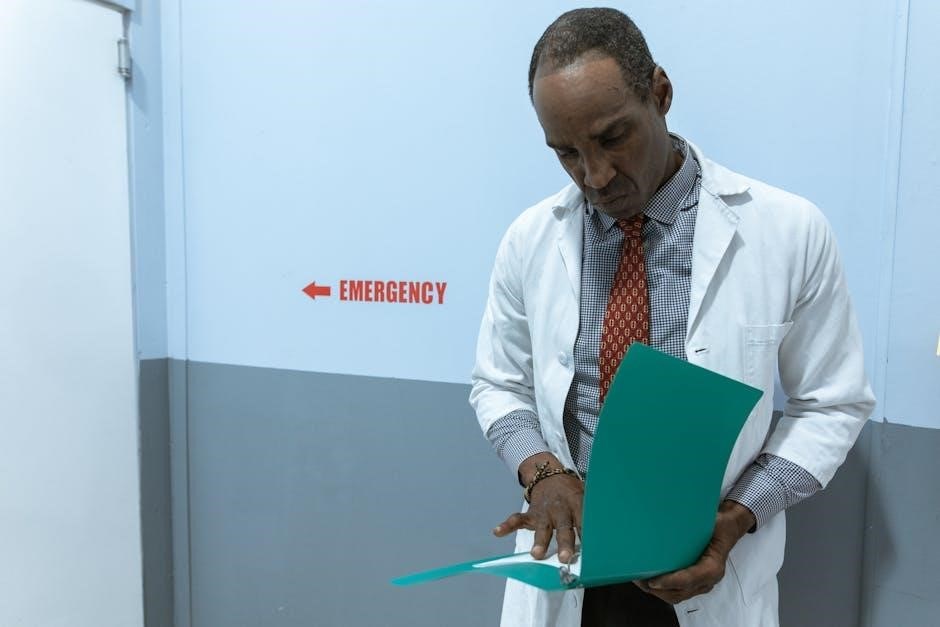
Elements of Effective Nursing Documentation
Effective nursing documentation ensures clear communication, accountability, and continuity of patient care. It adheres to professional standards, supports legal compliance, and reflects evidence-based nursing practices.
3.1 Key Components of Nursing Documentation
Nursing documentation includes assessment data, diagnoses, care plans, interventions, and patient responses. It should be clear, concise, and timely, reflecting the nursing process accurately. Key components involve patient-specific information, measurable outcomes, and evidence-based practices. Documentation must adhere to professional standards, ensuring consistency and accountability. It also includes communication between healthcare providers and serves as a legal record of care provided. Accurate and comprehensive documentation is essential for continuity of care and patient safety.
3;2 Standards and Guidelines for Accurate Documentation
Standards for nursing documentation emphasize accuracy, completeness, and timeliness. Guidelines include using clear language, avoiding abbreviations, and ensuring patient confidentiality. Professional organizations like the American Nurses Association (ANA) and the Nursing and Midwifery Council (NMC) provide frameworks to guide documentation practices. Adherence to these standards ensures consistency, accountability, and compliance with legal requirements. Documentation must reflect evidence-based practices, patient-centered care, and interdisciplinary communication. Following these guidelines supports high-quality care and maintains professional integrity.
3.3 Use of Nursing Terminologies and Classification Systems
Nursing terminologies and classification systems, such as NANDA, NIC, and NOC, standardize documentation, ensuring consistency and clarity. These systems provide a common language for care planning, implementation, and evaluation. They enhance interoperability across healthcare settings and support accurate data collection. By using standardized terminologies, nurses can improve communication, reduce errors, and facilitate data analysis for research and quality improvement. Integration of these systems into electronic health records further streamlines documentation and promotes evidence-based practice.
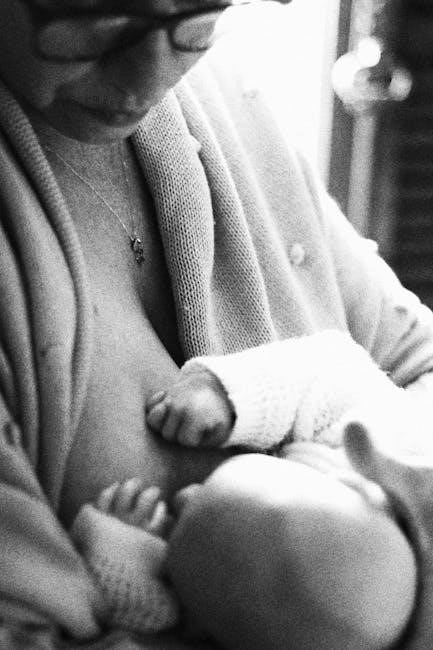
The Nursing Process and Documentation
The nursing process—assessment, diagnosis, planning, implementation, and evaluation—guides patient care and documentation, ensuring comprehensive, patient-centered records that reflect care outcomes and accountability.
4.1 Assessment Phase
The assessment phase involves systematic data collection about the patient’s physical, emotional, and social condition. Nurses gather information through observations, interviews, and medical history reviews. This phase documents baseline health status, identifying needs and concerns. Accurate and detailed records ensure continuity of care and inform the next steps in the nursing process. Clear documentation of assessment findings is crucial for developing targeted care plans and ensuring patient safety and accountability. It sets the foundation for the diagnosis and planning phases, guiding evidence-based interventions.
4.2 Diagnosis Phase
The diagnosis phase involves identifying the patient’s health issues based on assessment data; Nurses formulate nursing diagnoses that describe the patient’s actual or potential health problems. This phase documents specific conditions, such as activity intolerance or pain, and their related factors. Accurate diagnosis documentation ensures targeted care planning and continuity of interventions. It also facilitates legal accountability and clear communication among healthcare providers, aligning the care plan with the patient’s needs and promoting effective outcomes.
4.3 Planning Phase
The planning phase involves developing a care plan based on the nursing diagnosis. It includes setting SMART (Specific, Measurable, Achievable, Relevant, Time-bound) goals and outlining interventions. Documentation in this phase ensures the plan is clear, individualized, and aligned with evidence-based practices. The care plan is communicated to the healthcare team, promoting collaboration and continuity. Accurate documentation here serves as a legal and professional record of the agreed-upon plan, ensuring accountability and guiding future care decisions effectively.
4.4 Implementation Phase
The implementation phase involves executing the care plan, with nurses administering treatments and interventions. Documentation here records patient responses, progress, and any adjustments made. This phase ensures care is delivered as planned, with documentation supporting continuity and accountability. Accurate records of interventions, outcomes, and patient feedback are essential, providing a clear audit trail and facilitating effective communication among healthcare providers. This step is critical for patient safety and legal compliance, ensuring all actions align with the established care plan and professional standards.
4;5 Evaluation Phase
The evaluation phase assesses the effectiveness of care and patient outcomes, ensuring goals are met or adjusted. Nurses document patient responses, progress, and any remaining needs. This phase confirms whether interventions were successful or require modification. Accurate documentation supports accountability, continuity of care, and future planning. It also provides insights for improving care quality and patient safety, while maintaining legal and professional standards. Evaluation documentation is vital for reflecting on care effectiveness and informing next steps in patient management.

Legal and Ethical Considerations
Nursing documentation must uphold confidentiality, patient privacy, and professional accountability. It ensures compliance with legal standards, protecting both patients and nurses while fostering trust and ethical healthcare practices.
5.1 Confidentiality and Patient Privacy
Nursing documentation must maintain patient confidentiality and privacy, adhering to legal and ethical standards. Confidentiality ensures that personal health information is protected from unauthorized access. Nurses must comply with regulations like HIPAA and the NMC Code, which emphasize the importance of safeguarding patient data. Breaches of confidentiality can lead to legal consequences and loss of trust. Secure storage, limited access, and encrypted systems are essential to uphold patient privacy in both physical and electronic records, ensuring ethical practice and compliance with healthcare laws.
5.2 Professional Accountability and Liability
Nursing documentation serves as a legal record of professional accountability, reflecting the quality of care provided. Accurate and complete records protect nurses from liability by demonstrating adherence to standards of practice. Inaccuracies or omissions can lead to legal consequences, emphasizing the importance of precise documentation. Nurses are legally responsible for their actions, and proper documentation ensures transparency and accountability, safeguarding both patients and practitioners. It also provides evidence of compliance with professional standards and ethical practices in healthcare delivery.
5.3 Compliance with Healthcare Regulations
Nursing documentation must comply with healthcare regulations to ensure patient safety, data privacy, and legal standards. Accurate records align with laws like HIPAA and professional guidelines, preventing legal issues. Proper documentation demonstrates adherence to care standards, protecting healthcare providers and institutions. It also facilitates audits and inspections, ensuring transparency and accountability. Compliance with regulations reinforces trust in healthcare systems and upholds ethical practices, making it a cornerstone of professional nursing care and legal responsibility.
Benefits of Accurate Nursing Documentation
Accurate nursing documentation improves communication, enhances patient outcomes, and supports legal and reimbursement processes, ensuring transparency, accountability, and high-quality care delivery.
6.1 Enhanced Communication Among Healthcare Providers
Accurate nursing documentation enhances communication among healthcare providers by ensuring clear, concise, and accessible information. It facilitates seamless coordination of care, reducing misunderstandings and errors. Well-documented records allow all team members to track patient progress, align interventions, and make informed decisions. This transparency fosters collaboration, improving overall care quality and patient safety. Effective documentation also ensures consistency in reporting, enabling healthcare providers to work cohesively toward shared goals, ultimately benefiting patient outcomes and care delivery processes.
6.2 Improved Patient Outcomes
Accurate nursing documentation directly contributes to improved patient outcomes by ensuring care is based on comprehensive, up-to-date records. It prevents errors, promotes continuity of care, and supports personalized treatment plans. Clear documentation enables healthcare providers to track patient progress, identify needs, and make informed decisions. This leads to better management of health conditions, enhanced safety, and more effective care delivery. Ultimately, precise documentation empowers nurses to deliver high-quality, patient-centered care, improving overall health outcomes and patient satisfaction.
6.3 Support for Reimbursement and Legal Processes
Accurate nursing documentation is vital for reimbursement and legal processes, serving as evidence of care provided. It ensures compliance with billing requirements and supports insurance claims. Detailed records protect healthcare providers in legal disputes, demonstrating adherence to standards of care. Thorough documentation also facilitates audits and reviews, verifying the quality and appropriateness of services rendered. This accountability ensures transparency and aligns care delivery with regulatory and professional standards, safeguarding both patients and healthcare organizations.
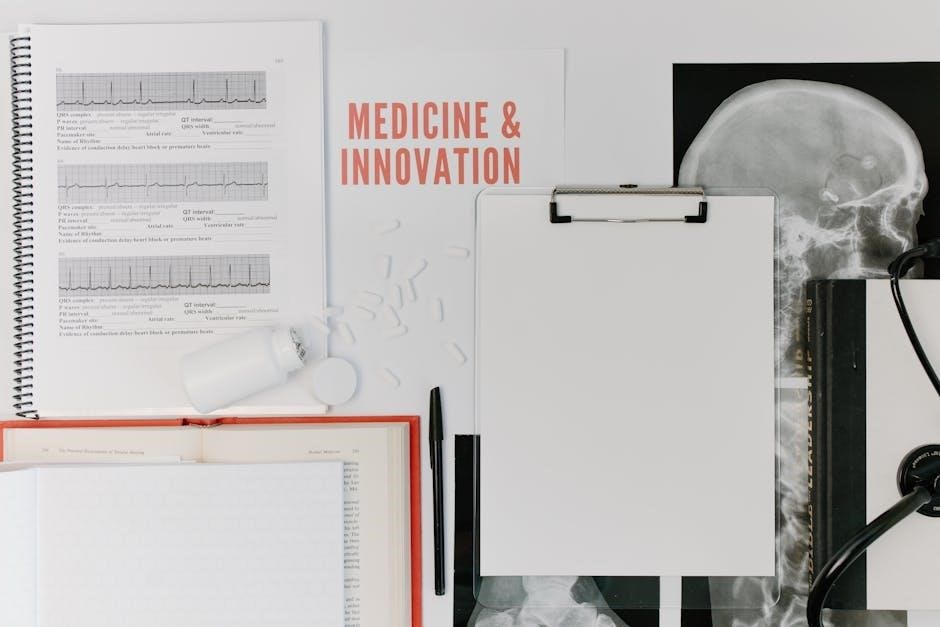
Challenges in Nursing Documentation
Nursing documentation faces challenges like time constraints, heavy workloads, and complex systems, which can hinder accuracy and consistency, impacting patient care and legal compliance.
7.1 Time Constraints and Workload
Time constraints and heavy workloads are significant challenges in nursing documentation. Nurses often juggle multiple patients and tasks, leaving limited time for thorough documentation. Rushed documentation can lead to errors, omissions, or inaccuracies, compromising patient care and legal compliance. Additionally, the complexity of electronic health records (EHRs) can further reduce efficiency, exacerbating time management issues. Addressing these challenges requires streamlined processes, time-saving tools, and workload redistribution to ensure accurate and timely documentation.
7.2 Complexity of Documentation Systems
The complexity of documentation systems poses a challenge for nurses. Electronic Health Records (EHRs) often feature intricate designs with multiple features, requiring extensive training to navigate effectively. Integration with other healthcare systems can complicate workflows, leading to documentation errors. Additionally, the lack of standardization across systems and frequent updates further burden nursing staff, reducing efficiency and increasing the likelihood of inaccuracies. Simplifying and standardizing documentation systems is essential to improve usability and reduce barriers to effective documentation.
7.3 Ensuring Consistency and Accuracy
Ensuring consistency and accuracy in nursing documentation is crucial for reliable patient care. Regular audits and reviews help identify errors and improve standards. Standardized templates and guidelines reduce variability, while ongoing training enhances understanding of documentation principles. Leveraging technology, such as electronic health records (EHRs), automates checks and alerts, minimizing inaccuracies. Collaboration among healthcare teams and clear communication further promote precision and uniformity, ensuring that documentation faithfully reflects patient care and supports informed decision-making across the healthcare continuum.
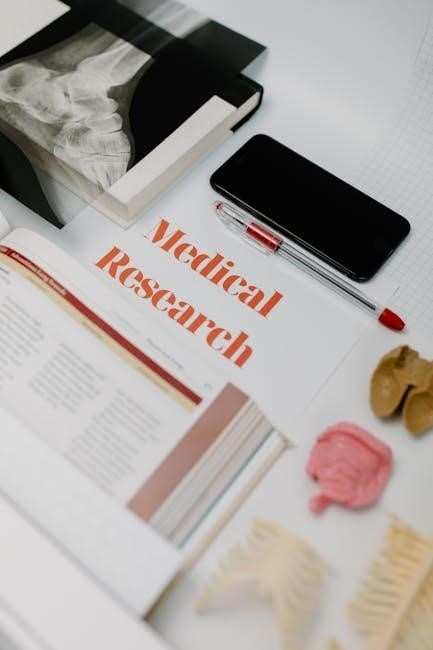
Technology in Nursing Documentation
Technology enhances nursing documentation through electronic health records (EHRs), improving efficiency, accuracy, and accessibility. Mobile apps and interoperable systems streamline data sharing, ensuring seamless communication and compliance with regulations.
8.1 Electronic Health Records (EHRs)
Electronic Health Records (EHRs) have revolutionized nursing documentation by enabling secure, real-time access to patient data. EHRs improve accuracy, reduce duplication, and enhance care coordination; They support evidence-based practice, facilitate compliance with regulations, and provide a centralized platform for tracking patient histories. Transitioning from paper-based systems to EHRs has streamlined workflows, reducing errors and improving communication among healthcare providers. EHRs also enable seamless data sharing and contribute to better patient outcomes through standardized and interoperable documentation practices.
8.2 Mobile Health Applications
Mobile health applications are transforming nursing documentation by enabling real-time data access and remote patient monitoring. These apps streamline documentation workflows, reduce errors, and enhance patient engagement. Nurses can securely update records, access care plans, and communicate with teams via mobile platforms. Mobile health tools also support point-of-care decision-making, improve data accuracy, and facilitate timely interventions. Their portability and ease of use make them invaluable for modern nursing practices, especially in community and remote care settings.
8.3 Interoperability and Data Sharing
Interoperability and data sharing are critical for seamless communication in healthcare; Standardized systems enable secure exchange of patient data across platforms, improving care coordination; Nursing documentation benefits from interoperability, ensuring consistency and accessibility. It supports legal processes, enhances patient safety, and streamlines workflows. Effective data sharing fosters collaboration among healthcare providers, promoting high-quality, patient-centered care while maintaining confidentiality and compliance with regulations.

Best Practices for Nursing Documentation
Best practices include clear, concise writing, timely documentation, and regular audits. Adhering to guidelines and using evidence-based practices ensures compliance, accuracy, and consistency in patient care records.
9.1 Clear and Concise Writing
Clear and concise writing is critical in nursing documentation, ensuring readability and understanding. It minimizes errors, enhances communication, and supports accurate care planning. Nurses should avoid jargon, use standardized terminologies, and document only essential information. The American Nursing Association emphasizes the importance of clear documentation for safe, evidence-based practice. Conciseness ensures that patient records remain focused, reducing ambiguity and improving care coordination among healthcare providers.
9.2 Timeliness of Documentation
Timeliness in nursing documentation ensures that patient records are accurate, up-to-date, and reflect current care activities. Delayed documentation can lead to misinformation and compromised care quality. The American Nursing Association emphasizes the importance of prompt documentation to maintain patient safety and continuity of care. Real-time updates, particularly in electronic health records, enhance communication among healthcare providers, reduce errors, and support efficient care coordination. Timely documentation also aids in legal compliance and reimbursement processes, ensuring transparency and accountability in patient care;
9.3 Regular Audits and Reviews
Regular audits and reviews of nursing documentation ensure accuracy, consistency, and compliance with standards. These processes identify gaps, improve documentation quality, and maintain patient safety. Audits also verify adherence to legal and ethical guidelines, reducing liability risks. The American Nursing Association recommends periodic reviews to uphold professionalism and accountability. For instance, the transition to electronic health records, as seen in Jersey Hospice Care, highlights the importance of audits in ensuring reliable and transparent documentation practices across healthcare settings.
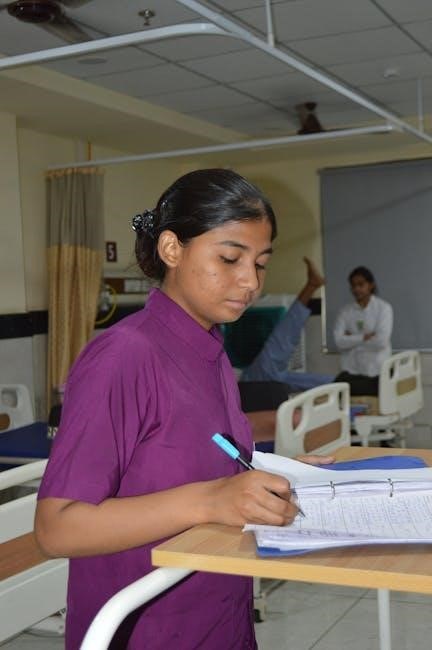
The Future of Nursing Documentation
The future of nursing documentation lies in AI, machine learning, and predictive analytics, enhancing efficiency and accuracy. Global standardization efforts will ensure consistency and interoperability worldwide.
10.1 Artificial Intelligence and Machine Learning
Artificial intelligence (AI) and machine learning (ML) are revolutionizing nursing documentation by streamlining tasks like data entry and enhancing accuracy. AI-powered tools, such as voice recognition software, enable nurses to document care efficiently, reducing manual work. Predictive analytics can analyze large datasets to forecast patient outcomes, aiding nurses in decision-making. Additionally, AI can identify gaps in documentation, ensuring compliance and improving patient safety. These technologies are expected to play a pivotal role in modernizing nursing documentation, making it more efficient and patient-centered.
10.2 Predictive Analytics in Documentation
Predictive analytics is transforming nursing documentation by enabling early identification of patient risks and trends. By analyzing historical data, predictive models can forecast patient outcomes, such as readmission likelihood or disease progression. This capability allows nurses to tailor care plans proactively, improving patient safety and satisfaction. Predictive analytics also supports evidence-based practices, ensuring documentation aligns with best standards. Its integration into nursing workflows enhances decision-making, streamlining care delivery and optimizing resource allocation for better patient outcomes.
10.3 Global Standardization Efforts
Global standardization of nursing documentation is a priority, driven by organizations like WHO and ICN. These efforts aim to create unified guidelines and terminologies, ensuring consistency across borders. Standardized documentation enhances data sharing, improves care coordination, and supports global health initiatives. It also facilitates research and policy development, enabling comparisons and improvements in nursing practices worldwide. By adopting universal standards, the nursing profession can achieve greater clarity and efficiency in delivering high-quality patient care globally.
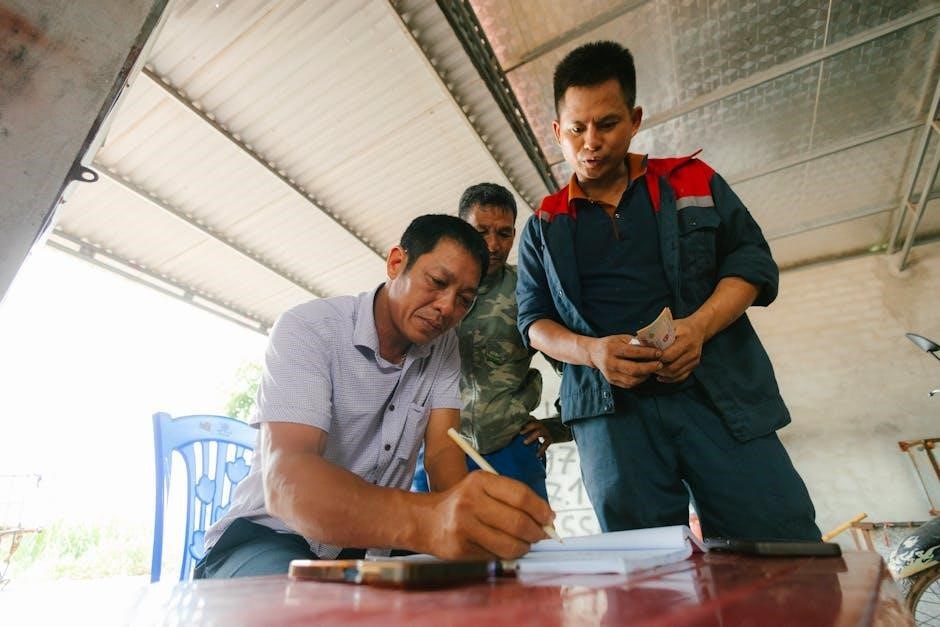
Appendices and Additional Resources
This section provides supplementary materials, including sample documentation templates, a glossary of nursing terminology, and recommended readings for further exploration of nursing documentation practices.
11.1 Sample Nursing Documentation Templates
Sample nursing documentation templates provide standardized formats for recording patient care. These templates include sections for assessment, diagnosis, care plans, progress notes, and discharge summaries. They ensure consistency and compliance with professional standards, making it easier for healthcare providers to communicate effectively. Templates are adaptable to various healthcare settings, such as hospitals, clinics, or home care. They also include spaces for medication administration records, vital signs, and patient education. Using these templates helps streamline documentation processes and improves accuracy, ensuring comprehensive patient care records are maintained. They are available in PDF formats for easy access and customization.
11.2 Glossary of Nursing Documentation Terms
A glossary of nursing documentation terms provides clear definitions for key concepts used in patient care records. Terms include assessment, diagnosis, care plan, implementation, and evaluation. It also defines legal and ethical terms like confidentiality and accountability. This resource helps ensure consistency in documentation, improving communication among healthcare providers. It serves as a quick reference for nurses, students, and professionals to understand the terminology essential for accurate and effective documentation practices in various healthcare settings.
11.3 Recommended Reading and References
Key resources include the State of the World’s Nursing 2025 report by WHO, offering insights into global nursing trends. The American Nurses Association’s (ANA) Principles for Nursing Documentation provides guidance for high-quality documentation. Additionally, WHO’s Global Strategic Directions for Nursing and Midwifery 2021–2025 outlines policy priorities. These resources, along with peer-reviewed articles and textbooks on nursing documentation, offer comprehensive knowledge for professionals seeking to enhance their documentation skills and stay updated on best practices in patient care and record-keeping.
Nursing documentation is a cornerstone of professional practice, ensuring continuity of care and accountability. It reflects the quality of patient interactions and outcomes, serving as a legal and ethical record. By adhering to best practices, nurses enhance communication, safety, and care quality. As healthcare evolves, accurate and efficient documentation remains vital, supported by technological advancements. Ultimately, high-quality nursing documentation fosters trust, improves patient outcomes, and upholds the integrity of the nursing profession, making it an indispensable tool in modern healthcare systems worldwide.
